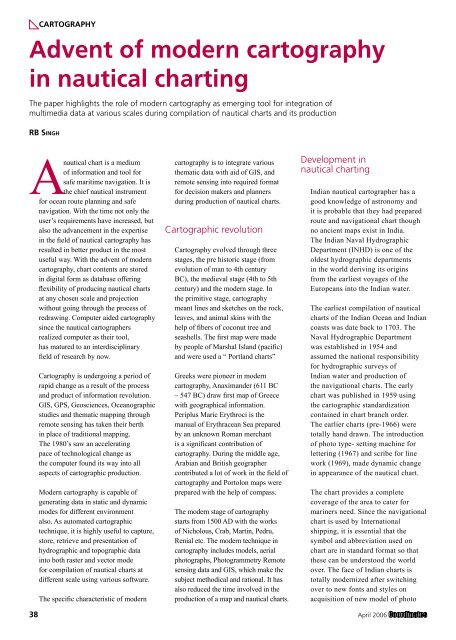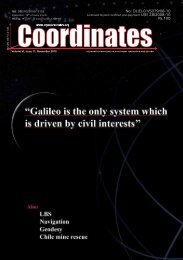Download - Coordinates
Download - Coordinates
Download - Coordinates
You also want an ePaper? Increase the reach of your titles
YUMPU automatically turns print PDFs into web optimized ePapers that Google loves.
CARTOGRAPHY<br />
Advent of modern cartography<br />
in nautical charting<br />
The paper highlights the role of modern cartography as emerging tool for integration of<br />
multimedia data at various scales during compilation of nautical charts and its production<br />
RB SINGH<br />
A<br />
nautical chart is a medium<br />
of information and tool for<br />
safe maritime navigation. It is<br />
the chief nautical instrument<br />
for ocean route planning and safe<br />
navigation. With the time not only the<br />
user’s requirements have increased, but<br />
also the advancement in the expertise<br />
in the field of nautical cartography has<br />
resulted in better product in the most<br />
useful way. With the advent of modern<br />
cartography, chart contents are stored<br />
in digital form as database offering<br />
flexibility of producing nautical charts<br />
at any chosen scale and projection<br />
without going through the process of<br />
redrawing. Computer aided cartography<br />
since the nautical cartographers<br />
realized computer as their tool,<br />
has matured to an interdisciplinary<br />
field of research by now.<br />
Cartography is undergoing a period of<br />
rapid change as a result of the process<br />
and product of information revolution.<br />
GIS, GPS, Geosciences, Oceanographic<br />
studies and thematic mapping through<br />
remote sensing has taken their berth<br />
in place of traditional mapping.<br />
The 1980’s saw an accelerating<br />
pace of technological change as<br />
the computer found its way into all<br />
aspects of cartographic production.<br />
Modern cartography is capable of<br />
generating data in static and dynamic<br />
modes for different environment<br />
also. As automated cartographic<br />
technique, it is highly useful to capture,<br />
store, retrieve and presentation of<br />
hydrographic and topographic data<br />
into both raster and vector mode<br />
for compilation of nautical charts at<br />
different scale using various software.<br />
The specific characteristic of modern<br />
cartography is to integrate various<br />
thematic data with aid of GIS, and<br />
remote sensing into required format<br />
for decision makers and planners<br />
during production of nautical charts.<br />
Cartographic revolution<br />
Cartography evolved through three<br />
stages, the pre historic stage (from<br />
evolution of man to 4th century<br />
BC), the medieval stage (4th to 5th<br />
century) and the modern stage. In<br />
the primitive stage, cartography<br />
meant lines and sketches on the rock,<br />
leaves, and animal skins with the<br />
help of fibers of coconut tree and<br />
seashells. The first map were made<br />
by people of Marshal Island (pacific)<br />
and were used a “ Portland charts”<br />
Greeks were pioneer in modern<br />
cartography, Anaximander (611 BC<br />
– 547 BC) draw first map of Greece<br />
with geographical information.<br />
Periplus Maric Erythroci is the<br />
manual of Erythracean Sea prepared<br />
by an unknown Roman merchant<br />
is a significant contribution of<br />
cartography. During the middle age,<br />
Arabian and British geographer<br />
contributed a lot of work in the field of<br />
cartography and Portolon maps were<br />
prepared with the help of compass.<br />
The modern stage of cartography<br />
starts from 1500 AD with the works<br />
of Nicholous, Crab, Martin, Pedru,<br />
Renial etc. The modern technique in<br />
cartography includes models, aerial<br />
photographs, Photogrammetry Remote<br />
sensing data and GIS, which make the<br />
subject methodical and rational. It has<br />
also reduced the time involved in the<br />
production of a map and nautical charts.<br />
Development in<br />
nautical charting<br />
Indian nautical cartographer has a<br />
good knowledge of astronomy and<br />
it is probable that they had prepared<br />
route and navigational chart though<br />
no ancient maps exist in India.<br />
The Indian Naval Hydrographic<br />
Department (INHD) is one of the<br />
oldest hydrographic departments<br />
in the world deriving its origins<br />
from the earliest voyages of the<br />
Europeans into the Indian water.<br />
The earliest compilation of nautical<br />
charts of the Indian Ocean and Indian<br />
coasts was date back to 1703. The<br />
Naval Hydrographic Department<br />
was established in 1954 and<br />
assumed the national responsibility<br />
for hydrographic surveys of<br />
Indian water and production of<br />
the navigational charts. The early<br />
chart was published in 1959 using<br />
the cartographic standardization<br />
contained in chart branch order.<br />
The earlier charts (pre-1966) were<br />
totally hand drawn. The introduction<br />
of photo type- setting machine for<br />
lettering (1967) and scribe for line<br />
work (1969), made dynamic change<br />
in appearance of the nautical chart.<br />
The chart provides a complete<br />
coverage of the area to cater for<br />
mariners need. Since the navigational<br />
chart is used by International<br />
shipping, it is essential that the<br />
symbol and abbreviation used on<br />
chart are in standard format so that<br />
these can be understood the world<br />
over. The face of Indian charts is<br />
totally modernized after switching<br />
over to new fonts and styles on<br />
acquisition of new model of photo<br />
38 April 2006

















